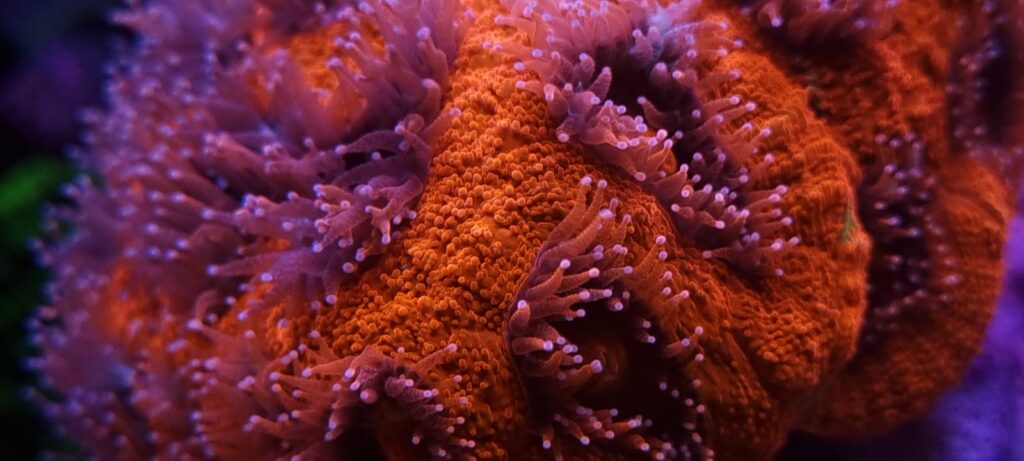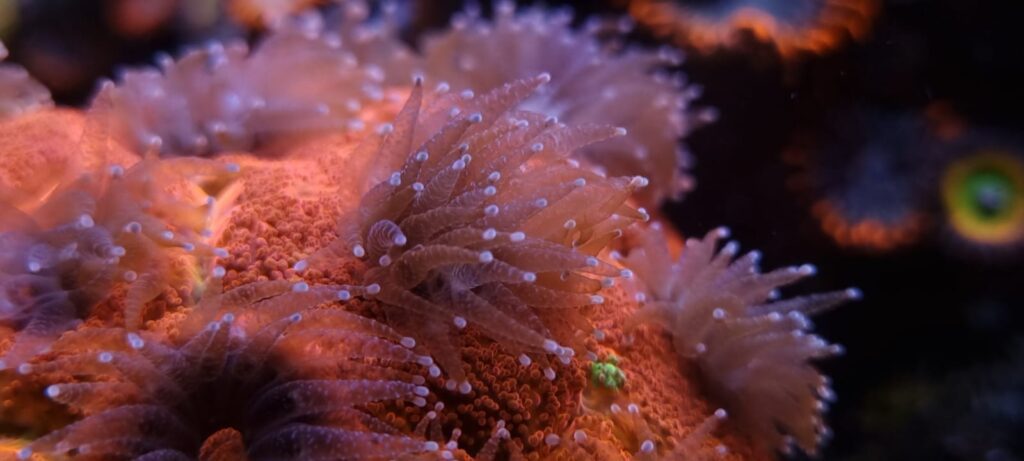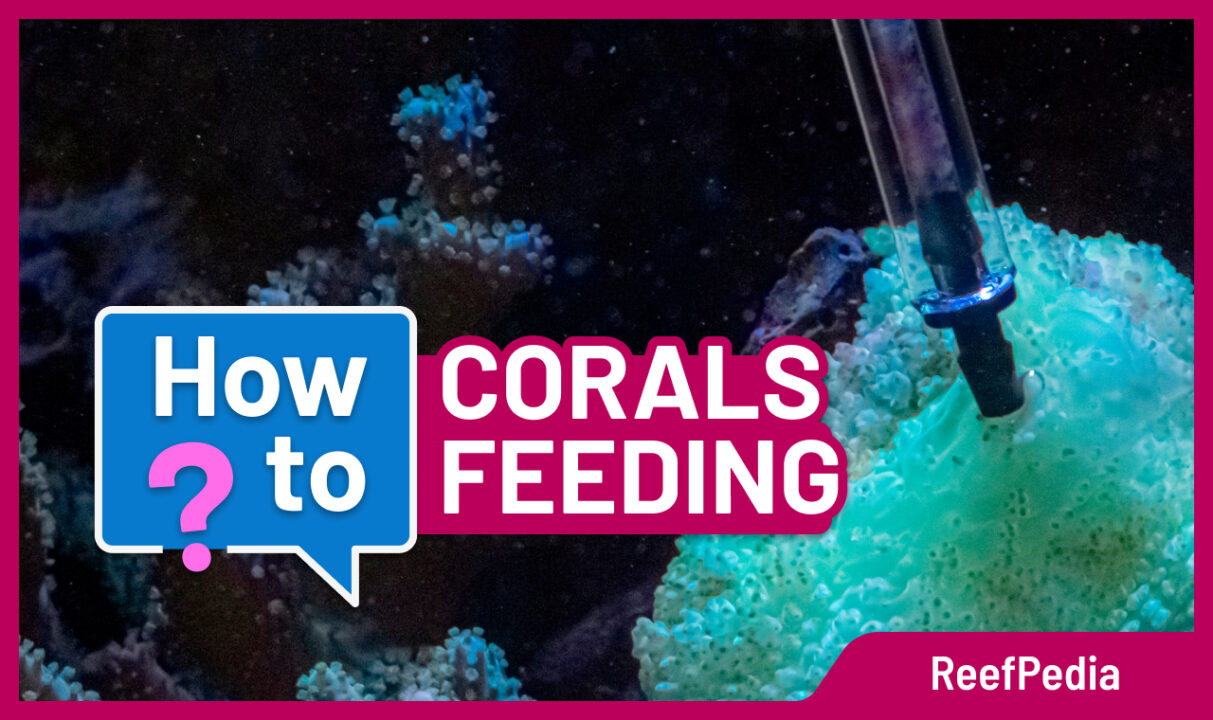Table of Contents
Do you know how to feed corals?
In this article I’ll try to describe how to properly feed these animals to get beautiful colors and growth. When corals are fed well, you’re be able to admire the most beautiful polyps of Euphyllia and impressive growth in Acropora. I will also suggest how to save animals that are on the verge of death.
Well-nourished corals have thick tissue, lots of zooxanthellae and grow well. In poorly nourished ones, we have the opposite phenomenon, i.e. thin tissue and little zooxanthellae. In Acropora corals, thin tissue makes pastel colors visible, but this is a physiological condition in which the coral is sensitive to stress. A malnourished coral with thin tissue is more sensitive to excessive light, or so-called overexposure. If such a weak individual is exposed to excessive light, the zooxanthellae living in its tissues will start producing oxygen so quickly that the coral will not be able to consume it or excrete it into the environment. The oxygen will turn into free radicals, and they will damage the DNA of the zooxanthellae and cause them to die. Thus, the coral will turn white. Without zooxanthellae, it will not be able to carry out photosynthesis and obtain energy this way. It will start to starve to death. The only way to save it will be to move it to a shady place and provide it with very easily digestible foods. Which ones, I will write later. However, beware the stick has two ends, and in turn, if we overfeed the corals, they will have very thick tissue and huge amounts of golden-brown zooxanthellae, as a result of which they will turn brown. That is, unfortunately, we will get all shades of brown in the tank, and this is not what coral reefs are all about. So how to feed so as not to get this effect and overfeed? I will try to answer this question.
Let’s start with a few word on how to feed corals.
Have you ever wondered how corals eat?
Autotrophism, or self-nutrition, refers to the ability to transform inorganic substances taken from outside into organic substances necessary for living. This is how plants feed. Most animals are heterotrophs, or adulterants – organisms that feed by taking in food from outside. There is no doubt that corals are animals. Some coral species have established a close cooperation (symbiosis) with single-celled algae, known as zooxanthellae. The latter inhabit corals and, in exchange for a place to live, trade them some of the food obtained during photosynthesis. Corals thus obtain 60-80% of the energy they need to live. However, this is not enough to get proper growth. Corals get the rest of their food in a typical animal way. They take food from the depths of the water. They absorb dissolved inorganic and organic compounds through the tissue and larger food through the mouth leading to the absorptive digestive cavities.

What to feed them?
Regardless of species, corals consume inorganic and organic compounds from the water. In this way they obtain: organic nitrogen, ammonia, amino acids and sugars. Amino acids are organic compounds that are the building material of all proteins. Coral cells are sensitive to this liquid food. Therefore, amino acids and especially arginine added to the water will cause the coral to begin to polyp. Due to the polyp and the opening of the mouth apparatus, the coral prepares itself to receive more nutrients. Therefore, amino acids, for example, in the form of boosters, are used to feed corals; they are often given moments before the next foods with higher gradation are given.
Taking liquid food from the water is a method of feeding corals that allows the regeneration of weakened specimens. Organic compounds absorbed by the tissue allow it to rebuild, especially zooxanthellae, even when starved corals are unable to take larger chunks of food. An hour-long bath in amino acids and glucose brings some overexposed corals back to life. Such corals are often placed in the shade in tanks with slightly increased nutrients such as NO3. I will describe this process in more detail in an article on coral treatment.
Most corals can consume detritus, so they revive when we blow off the rock. They catch the particles and extract valuable nutrients from them. However, remember that detritus deposits increase NO3 and PO4, so it should be removed from the tank with mechanical filtration and appropriate selection of animals that feed on detritus and dig up the sand. Among the best-known detritus eaters is the popular snail Strombus detritus.
Zooplankton or phytoplankton is also an important component of the coral diet. The type of plankton consumed depends on the structure of the coral’s polyps. Soft corals have small polyps known as pinnules. They contain enzymes that enable them to digest plant food. Therefore, soft corals are herbivores that feed on plant plankton (phytoplankton). Due to the structure of the pinula, soft corals mainly take food with small particles. There are exceptions to this rule, e.g. Fungi (Corallimorpha) already have a slightly differently constructed mouth and can handle larger food.
SPS and LPS corals have adapted to actively hunt. SPSs are generally characterized by smaller polyps and feed on small zooplankton – such as rotifers. LPSs have longer polyps that help catch larger plankton. They prey on artemia, lasonopods and krill.
Counted as LPSs, large-polyp species, e.g., Trachyphyllia and Scolymia, have developed a very large mouth and elaborate polyps, enabling them to take meat food in large chunks. In doing so, they show less need for light, and are not fond of strong water circulation. There are also non-photosynthesizing corals that do not cooperate with zooxanthellae and require daily feeding. Their advantage is that they can develop properly in the shade, so they are a very interesting variety of the tank. It is worth mentioning here that corals are remarkable animals that show extraordinary adaptability. Montiporas under normal conditions obtain their nutrients mainly from photosynthesis, but with the disappearance of zooxanthellae, some of their varieties are able to behave like non-photosynthetic ones and begin to take nutrients from the water.
How to feed them?
To begin with, you need to realise that feeding corals puts a strain on the filtration system, which can lead to a change in water parameters and, more precisely, to an increase in nitrate and phosphate levels to toxic levels for the animals. This can be prevented by using: a skimmer, mechanical filter or refugium. But above all, by properly adjusting the feeding rations.
How to start feeding corals. It is necessary to turn off mechanical filters. During feeding it is worth turning off the skimmer. If this is not done, it will skim out a significant part of the food. Of course, it is also desirable to lower the circulation or turn off the pumps, which makes it easier for the corals to calmly grab the food. We restart the devices after the feeding is completed.
The corals’ meal should start with a starter of amino acids or polyp-boosters. Then we can give loose foods, providing lipids and larger proteins, they should be dissolved in salt water and poured into the aquarium or pipetted directly near the mouth of the coral. I supplement the diet with small zooplankton in the form of rotifers, copepods and larger zooplankton in the form of frozen food. I dissolve frozen foods in a bucket of salt water taken from the tank, and often mix them with the aforementioned loose foods. An important point – zooplankton stresses the system, if it falls on the rock or in the nooks and crannies of the tank and is not eaten in a short time it begins to decompose and raises the level of nitrates and phosphates, so be very careful and it is best to feed it with a pipette directly near the mouths of corals. I feed large-polyp corals with artemia and krill and pieces of styne or shrimp meat, but feed it near the mouth opening.
In my aquariums I often use phytoplankton. Not only as food for corals. Natural zooplankton in tanks such as Artemia feed on phytoplankton. With regular feeding of phytoplankton, we can see an increase in the amount of zooplankton in our aquariums in a short period of time.

There is one important rule in feeding corals – never overfeed!
All those who start their adventure with corals should start with very small doses of food. The amount stated by the manufacturer on the package should be reduced. Start feeding, for example, ¼ of the daily dose and observe the parameters. If nitrates and phosphates do not increase and no algae are seen, you can gradually increase the portions. Feeding food in the mouth area, we can easily overdose. Here it is worth paying attention to choose the size of the food according to the size of the mouth of the coral. If we feed Euphylla with coarse krill in large quantities, it may not be able to digest and excrete such food and the undigested excess begins to decompose, causing dangerous bacterial infections.
Remember that you should not feed purchased corals immediately after transport. The thing is that in the transport bags there is quite a high concentration of ammonia and low pH. These are not comfortable conditions and the animals need a few days of rest to recover.
Do corals feed during the day or at night?
In natural conditions on the reef, corals feed at night. They open their mouths and pull out polyps. On a coral reef at night there is dense zooplankton, and this is why corals hunt at night. In aquariums, we can also feed at night, when the corals are ready to feed. For this reason, it seems logical to feed corals after lights out, but in aquariums there are several variables that prompt us to feed during the day. At night, the pH in aquariums drops a lot, as you can read about in articles on this phenomenon. Low Ph disrupts and inhibits the processes of calcification, or skeletal buildup. It is true that corals can adapt to these conditions of falling pH at night, but it takes about 8 weeks. On the other hand, during the day there is no problem of pH drop and corals can be induced to feed and polyp by giving liquid amino acids to the water. Therefore, the choice of the time of the stone can be quietly adapted to your schedule.
Summary
Remember that if we want to get beautiful colors and visible growth of our corals we should feed them. It is important not only to choose the right size of food for the aquarium’s stocking density, but also its quality and feeding method. Unfortunately, a penny of aquarists tend to overfeed, so feeding doses should be adjusted according to aquarium consumption. Proper feeding not only benefits our corals, but also gives us great joy and the opportunity to watch these amazing animals feed.
About the author

Dorota Protasewicz
I’ve been surrounded by aquariums since childhood. I set up my first tank with my dad's support when I was 5 years old. My life partner and the father of our two wonderful sons is also an aquarist - Marek.
About 10 years ago, it was Marek who brought home the first marine aquarium. Only a 400-liter tank made me fall in love with the saltwater hobby and I took up building, setting up and running marine aquariums professionally, running my company - Crazy Coral
I also take care of distribution of Reef Factory smart aquarium devices to Poland, Germany, the Czech Republic and Switzerland. By trade, I’m a molecular biologist, which enabled me to conduct research on the effects of stress on corals. I cooperate with the Morski Instytut Rybacki (Sea Fisheries Institute) in Gdynia and the University of Gdańsk. I was also the manager of an EU research project on coral farming in inland aquaculture. Currently, together with the Polish Academy of Sciences, I am continuing this research at Crazy Coral. I hope to grow more stress-resistant corals that will allow us to rebuild damaged reefs.
I love combining professional work with my greatest hobby and working with people with the same interests.

